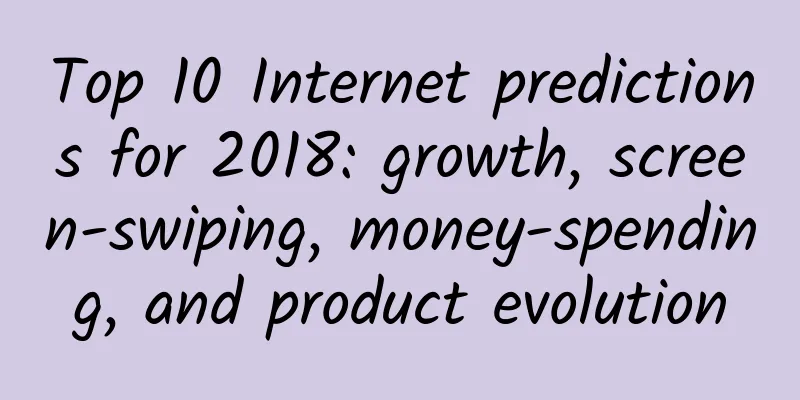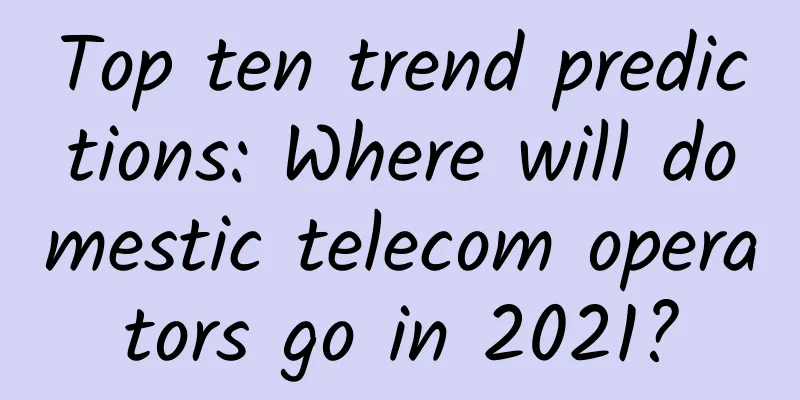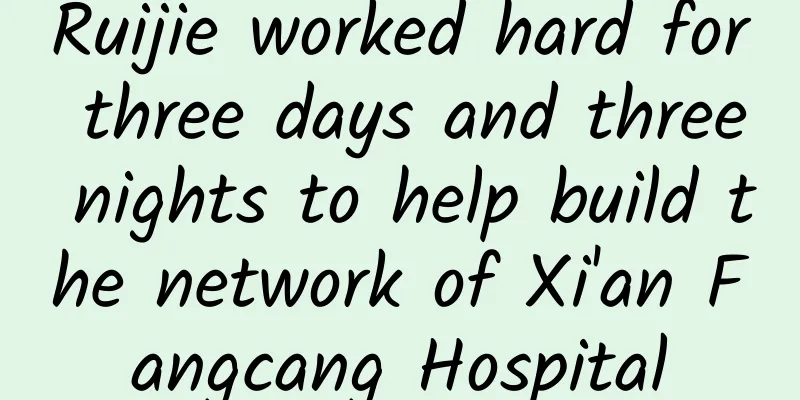Top 10 Internet predictions for 2018: growth, screen-swiping, money-spending, and product evolution

|
Another year has passed, winter has gone and spring has returned. The first two months of each year in the Internet industry are not only the peak period for recruitment and job hunting, but also the time when major Internet companies intensively adjust and formulate new strategies and business structures. Undercurrents are surging and changes are constant. Soon after the Spring Festival, more people began to feel the severity of the so-called "second half" of the Internet. Momo acquired Tantan, the battle between Didi and Meituan was about to break out, and "blockchain" quickly became a hot topic among the public... Such an era always makes too many people excited and confused. Therefore, we tried to make 10 important "guesses" about some major changes that may occur in the entire Internet industry in 2018 based on our own judgment and thinking. Unlike other common "guesses", our guesses and thoughts are more focused on specific business levels such as "products", "operations" and "growth", rather than macro capital levels such as investment trends and business trends. This is because our consistent position is to hope that more people, especially newcomers aged 0-5 in the Internet industry, can pay more attention to business practice and implementation, rather than talking too much about empty industry trends. All the contents of this article are made by the official website of Sanjieke based on their subjective judgment, analysis and speculation, and are not guaranteed to be reliable. Any similarity is purely coincidental. I hope this article can give you some inspiration and thinking. 1. Keywords: technology product innovation Starting from 2018, the Internet industry may see a series of "big product years". From the perspective of the entire industry, the development and innovation of the Internet industry have always been driven by three core forces: technology, products and operations. If we look back at the 20-year history of Internet development from 1998 to the present, we will find that technology, products and operations have always alternately driven the development and competition of the industry and have shown a certain periodicity. Specifically, in any emerging industry or field in the Internet world, early technology always takes the lead, completing the construction of a large amount of underlying infrastructure, and then entering an era where technology needs to be transformed into "products". Many products begin to carry out countless innovations and fierce competition in product form, user experience and other aspects, showing a trend of flourishing. Subsequently, when product competition reaches a stage where there is little room for innovation, the focus of competition begins to shift to the "operation" level, with everyone competing more on strategy, operating rhythm, and degree of refinement. In the end, innovation, development and competition centered around a type of technology will always reach a bottleneck. Therefore, when commercial competition based on old technologies and underlying infrastructure gradually becomes clear and stable, it is often the time when new technologies begin to take shape, and new technologies will also usher in a new round of competition and development cycle. Looking back, from the larger PC Internet era to the mobile Internet era to today's artificial intelligence, and then to more specific search technology to P2P technology and then to big data, almost all of them are highly consistent with this trend. If we only look at the development of the Internet in the past 10 years, we have actually experienced and replicated this cycle. (1) 2008 - 2012: Communication standards such as 3G and 4G networks, various mobile terminals such as smart phones, and various application service platform technologies such as HTML 5.0 have gradually matured from conception, birth, and application, and are gradually able to support large-scale application scenarios. The focus of commercial competition in the mobile Internet is mostly on the "technology" end. (2) 2010 - 2015: Various product forms based on mobile scenarios began to emerge on a large scale, and the focus of commercial competition in the entire mobile Internet shifted to the product side. A series of representative products including Weibo, WeChat, Baidu & Amap, Plants vs. Zombies, NetEase Cloud Music, Momo, etc. were born one after another. During this period, almost every sub-sector, from social networking to reading to tools to e-commerce, has experienced a process from hundreds of apps to a few products dominating the market. During the same period, books such as "Everyone is a Product Manager" became popular and made "product manager" the most popular position in the Internet industry, which can also be regarded as a representative event. (3) 2015 - 2018: A large number of products in the mobile Internet are beginning to become homogenized. It is difficult to gain a commanding position in commercial competition by relying solely on "product innovation" and "product experience". At the same time, the mobile Internet has begun to be combined with offline scenarios and in-depth services, and the focus of commercial competition has gradually shifted to the "operation" end. Especially in 2016 and 2017, the Internet industry experienced a big year for "operations". Products such as Didi, Meituan, and a large number of leading self-media that relied heavily on operational strategies and specific execution rose to prominence. Screen-sweeping events in WeChat Moments became the norm. The demand for operational talent in the entire Internet industry exploded, and books such as "Operations from Scratch" and "The Light of Operations" became popular. (4) 2017 - 2018: The business competition landscape brought about by the mobile Internet has gradually stabilized. The focus of competition has shifted from vertical application innovation competition within each sub-industry to the "big layout + big strategic competition" among giants. Industries have been shouting "the second half is coming", such as Tencent versus Alibaba, Toutiao facing Baidu, Meituan versus Didi, etc. This big landscape is almost difficult to shake. During the same period, the industry began to spawn a large number of new technologies including artificial intelligence, new retail under the influence of big data, blockchain, etc. On the other hand, in the past two years, users' "aesthetic fatigue" for products has gradually begun to emerge. In the past 2-3 years, super products such as WeChat, Toutiao, and Zhihu have always occupied the most time of users. When it comes to emerging products, at most we can add the names of Kuaishou and Douyin. This is very different from the situation in 2013-2015 when several interesting new products appeared every 1-2 months. Today, there are more and more users who sometimes feel that they don’t like to check their Moments and Zhihu that much anymore, but sometimes feel that there seems to be nothing else to check - in other words, in the subconscious of many users, they may be calling for the emergence of some new products. Therefore, by 2018, we believe that whether from the trend of industry development and evolution, from the potential demand of users, or from the accumulation and evolution of some old technologies + underlying infrastructure (such as mini-programs, VR, artificial intelligence, etc.), perhaps the Internet has approached the next time when it will be driven by "product innovation" and a large number of emerging products will emerge. 2. Keywords: 90s generation companion products Products that focus on loneliness, solitude, companionship, and homebodyism may be popular. In 2018, the first batch of post-90s were already 28 years old, and the youngest was already 19 years old - this basically means that among the entire core Internet user group, the most dynamic, mainstream, valuable, influential, and most capable of following trends is basically completely occupied by the post-90s. Generally speaking, since the post-90s generation, there have been more significant changes in some user behaviors and habits. Most of them have grown up alone and online, and are not good at expressing emotions in the real world and have a sense of loneliness that is difficult to be understood by others. Therefore, they are often more accustomed to expressing their emotions through the Internet, and are more accustomed to being alone in real life and finding their own belonging and sustenance in the online world. At the same time, the vast majority of those born in the 1990s who moved to first-tier cities from third-, fourth-, fifth-tier cities, and even towns, are facing such a situation: the high housing prices and real living costs have caused some people to gradually lose their longing for real life, but they are unwilling to return to small cities or towns. At the same time, another trend is gradually emerging, especially in first-tier cities - under various realistic pressures, the old marriage and family system is facing more and more impacts. And for more and more people, marriage and family are becoming more and more of a burden than a "spiritual pillar" in the non-traditional sense - on Zhihu, many questions like "Will the marriage system die out?" have begun to appear, and most of the followers tend to answer "support the dissolution of the marriage system." "Where are the kids?" and "My husband/wife doesn't come home" are becoming real challenges that more and more families have to face. A true story that once happened around us is that a product manager of Didi Chuxing, when investigating the motivations of Didi Express drivers to drive express cars, got an answer that was far beyond his expectations: the motivation for more than 85% of the express drivers to drive express cars in their spare time was "to get away from their wives and children at home and to have some time alone." Based on the above two aspects, we believe that among the mainstream Internet user groups, the subconscious feeling of loneliness and coldness, and the desire to find some emotional companionship and relief methods that belong only to themselves, will become more common. Therefore, we have an important conjecture - in 2018, products focusing on loneliness, companionship, homebody love, etc. may become more popular, and even national-level products/applications may appear periodically. Products such as Traveling Frog and Love and Producer launched at the end of 2017 are typical examples of this. If nothing unexpected happens, similar products will appear periodically in 2018. 3. Keywords: Spend money to grow and craft meticulously Internet products dominated by small and medium-sized companies and traditional enterprises basically have no chance of achieving large-scale growth by spending money. For a long time, "spending money" seems to be the most common, simplest and crudest but often extremely effective means of growth in the Internet environment. However, we believe that by 2018, a large number of small and medium-sized companies and some Internet products dominated by traditional enterprises will basically no longer have the opportunity and possibility to achieve large-scale growth by spending money. Specifically, the Internet in 2018 will show two significant trends on the user side:
In these two contexts, the user acquisition cost and the user's own migration cost when deciding whether to use a product will also be higher. Therefore, we believe that some products that are meticulously crafted and provide excellent experience will have greater explosive power in such an environment, and gain more imagination and room for imagination, a typical example being a product like TikTok.
But on the contrary, if your product is not mature and stable enough, then throwing money at it will be meaningless in such an environment. On the contrary, if the product itself is not mature enough, the more money you throw at it and the earlier it comes out, the easier it will be to be killed. For some small and medium-sized enterprises, when you have completed a product innovation and try to establish your status in the industry by spending money, it is bound to attract the attention of large companies. Once large companies with more resources and stronger product capabilities start to follow up, their advantages in competition will inevitably become more obvious. For example, you can try to review the status and process of the entire industry after the birth of live answering. As for some traditional enterprises, they often do not have strong product capabilities internally, and it is almost impossible for them to compete with large Internet companies in terms of "meticulous crafting" of products, so it is difficult for them to gain an advantage in the competition. Therefore, it can be said that Internet products dominated by small and medium-sized companies and some traditional enterprises will basically no longer have the opportunity and possibility to achieve large-scale growth by spending money. In such an environment, perhaps a more reliable way to survive is to slowly build up your reputation or provide more in-depth services. NetEase must be mentioned here. In our eyes, it is an alternative Internet company. Many of its products, from Cloud Music to Snail Reading, from Koala Global Shopping to Yanxuan, rarely use "spending money" as a core operating method. On the contrary, the route they have always chosen is to carefully craft it over a long period of time until its accumulated reputation is enough to support it to usher in a greater space for explosion, and then it will follow up with a series of supporting resources to help it move to the center of a bigger stage. If you are a small or medium-sized company, perhaps a more reasonable and reliable strategy in this environment is something like this. 4. Keywords: Marketing screen spamming risk "Screen-sweeping" marketing events may be more likely to occur in a concentrated manner, but the risks of pursuing "screen-sweeping" will increase. (Note: This section was written a week ago, but in fact, yesterday’s new world view screen-sweeping course has confirmed this to some extent) Regarding "screen swiping", it has always been something that all operations and marketing practitioners have been pursuing throughout their lives. Countless products have become an instant hit by relying on a screen swiping event, and countless people are proud of being able to create a "screen swiping" event. Before we talk about it, we first need to reach a consensus - in an environment dominated by social media, "screen-sweeping" events will definitely occur periodically - a social media must periodically have some popular hot spots to maintain its vitality. This is not only a need for user interaction in the entire environment, but also a necessity formed under the new communication logic. Generally speaking, a successful screen-sweeping event has two logics:
If we go back to common sense, the more mature an industry becomes, the more refined the division of labor and cooperation within the industry will be. Moreover, more segmented and focused division of labor will in turn be able to improve the work quality and effectiveness of the segmented jobs. Since the second half of 2017, we seem to be able to smell this more and more clearly in the field of "screen swiping" or "marketing centered on social communication". Specifically, it is manifested in:
Therefore, we believe that in 2018, in addition to some “accidental” content that goes viral, some “sweeping” marketing events may become more likely to occur as the dissemination rules of major social media platforms gradually stabilize + the trends mentioned above, and are more likely to be concentrated in some teams or large companies that have invested manpower and resources in this area for a long time (typical examples include New World View and NetEase). But at the same time, the risks of pursuing screen swiping may be increasing. The risks come from several aspects:
In short, whether or not to pursue screen swiping may become a question worthy of serious consideration for many people. 5. Keywords: Retention, Refined Operation, In-depth Service For most products, the weight of “retention” will be significantly greater than “growth” and “ignition”. In the Internet industry, there has always been a type of product that dies in a way called "born in attracting new users, died in retaining existing users." A typical example is Zuji, which became popular a few years ago. Today, the value of "retention" may be magnified again - when the traffic dividend is no longer there, users' time has become extremely scarce and fragmented, and they are becoming less and less patient, we believe that whether you can "create some long-term value and retain users for a long time" may be far more important than whether you can "quickly attract new users and detonate periodically." This stems from several logics:
In this context, we believe that the following capabilities that significantly contribute to "retention" will become extremely valuable to a product and Internet practitioners:
6. Keywords: Relationship chain scenarios drive product growth The use and value mining of the "relationship chain" will become the deciding factor for many products. This conjecture is once again related to the "disappearance of traffic dividends" and "user time is becoming more scarce and less patient". A basic judgment is: when an ordinary user is unable to digest information due to information overload, and even cannot distinguish the credibility of the information source, he is most likely to make and should make the choice that is most cost-effective for him, and is more likely to trust the person closest to him or the one he recognizes most. Therefore, in the current environment, if a product can achieve a large number of customer acquisition or business expansion based on the "relationship chain" of existing users, it will become a valuable commanding height. Products that can do this will have a great advantage in market competition. In particular, even based on the entire Internet industry, there are actually not many products and companies that have the genes and capabilities to do sufficient value mining based on the "relationship chain". Let’s take some examples to explain some typical logics of “value mining based on relationship chains”:
Among the above three, comparatively speaking, if you can do 2 and 3 well, the value will definitely be significantly higher than 1. 7. Keywords: job hunting, supply and demand contradiction, survival anxiety The shortage of high-end talents and the surplus of low-end talents in the Internet industry will become more serious. The survival anxiety of most product managers and operators will intensify. In short, in 2018, the entire Internet industry will face two structural changes:
The above two factors will inevitably lead to a more urgent need for a large number of Internet companies to improve business operation efficiency through centralized and productized solutions, as well as a significant increase in demand for mid- to high-end talents who can drive business development more efficiently, while the demand for low-end talents will decrease. Among these, due to the needs for refined operations, differentiated competition, more stable business development operations, etc., the entire industry is expected to have a more significant increase in demand for data analysis-related talents, product and operation talents with strong strategic capabilities, and product, operation, and marketing talents who have a deep understanding of the business and at the same time have expertise. However, although the demand for relevant talents has increased, the requirements for the comprehensive quality and ability of practitioners have not decreased. Therefore, in the Internet industry, "whether or not you have strong data analysis and strategy formulation capabilities" and "whether or not you have a deep understanding of the business" may become a major watershed for practitioners. Many product and operation practitioners who cannot cross this watershed are likely to be marginalized and have no opportunities. Overall, in the short term, the situation in the Internet industry where "mid- and low-end talents are flooding and high-end core talents are extremely scarce" will not change, and the contradiction between the supply and demand sides of talents will exist for a long time. 8. Keywords: Only speed can beat slowness. The product is amazing when it is launched. “Speed is everything” may become a thing of the past in the product industry. In 2014, with the rapid rise of Xiaomi, Lei Jun proposed the seven-word Internet strategy of "focus, innovation, word of mouth, and speed", among which "speed is invincible" was once regarded as the guiding principle by many Internet companies. But now, things may be starting to change. Many years ago, the early versions of QQ and WeChat were indeed somewhat horrible, and the idea of "launching first and then quickly iterating" runs through the development process of countless giant products today. However, we must be aware of some differences now - users in the past were hungry because they wanted; while users now are indifferent because they are afraid of choosing. In the past, it was difficult to copy a product; today, copying a product can be done extremely quickly. When a new product model appears (such as the "Top 100" conference at the beginning of the year), dozens of similar products will emerge in a short period of time. Some people even joked that what limits China's Internet is no longer the development speed, but the review speed of Apple. In this case, what product will be remembered and sung? Perhaps it is those products that are amazing as soon as they are launched, and are so well made that they make people scream. If we count the popular products recently, they are all like this:
Therefore, in today's environment, "speed is everything", may no longer have such magical power, at least in the initial stage of a product launch. For more product operators, this era may believe in this logic: a good product should be amazing when it is launched. 9. Keywords: Strategy Talent Gap Refined Operation "Strategic" talents will become a common and urgent need in the entire industry. This conjecture is closely related to the "talent supply and demand issue" mentioned in Prediction 7 above and the "ability to rely on data and strategies for refined operations will become more important" mentioned in Prediction 5. In the Internet industry, with the rise of many products such as Didi and Toutiao in recent years, "strategy" has become a word that attracts more and more attention, and positions including "strategy product manager" have become more well-known. The so-called "strategy" is often a set of rules and mechanisms driven by data and existing in the product. It is mostly used to solve problems such as recommendations, supply and demand matching, refined operations based on user stratification, dynamic pricing, large-scale subsidies, risk control, and anti-fraud. The purpose is to improve the overall operating efficiency of the business. Specifically, if the core business of an enterprise is highly dependent on human work, the management of employees may be extremely complex and difficult to ensure stability; while if the core business of a company relies on machines, it will be very stable and sustainable. What supports the operation of machines is strategy. The one who formulates the strategy for a product is not the boss, but the product manager, growth manager, user operation and other talents who have "strategic" capabilities. The quality of their strategies will determine which product has lower operating and maintenance costs, higher efficiency and more stable business. For example: (1) Didi Taxi: Before the emergence of Didi Taxi, there has always been a 96103 telephone taxi dispatch. Even though this dispatch imposed KPI assessments on drivers, the dispatch efficiency was still very low. The reason is that the multi-terminal matchmaking of passengers and drivers based on geographical locations is inefficient through manual processing, and as long as one party has a poor user experience, the other party will collapse. The matchmaking process of Didi Taxi does not involve human factors and is completely based on hundreds or thousands of strategies to complete the dispatch work. (2) Toutiao: Before the emergence of Toutiao, news topics have always been produced by a combination of machine collection and editing. For example, Sina may have hundreds or thousands of editors responsible for different channels. However, due to human factors, a large number of duplicate reprints were caused. In principle, Toutiao, which uses machine algorithms, can automatically and quickly generate channels without relying on any editor, and assign an article to N related channels. Different users can also see completely different homepages and content. Therefore, when it comes to processing and matching massive amounts of information, machines are destined to be more reliable than humans. As a business operator, do you want to manage a bunch of people and rely on a bunch of strategies that can be continuously iterated and improved? In addition, the threshold for cultivating and applying "strategic" talents is also being lowered. Five years ago, all companies that could do AB testing were rare, but now you only need to connect a piece of code to complete AB testing; in the past, tracking user behavior was quite troublesome, but now through advanced statistical analysis tools and third-party tools, we can get all the events of a user from the moment he enters the platform. These technologies were previously only available to a few large companies, but now startups can also adopt them very easily. In this context, you will have more time to think about your core business and improve the core user experience by formulating strategies. At present, many companies have been able to develop automated operation systems, automatically conduct AB testing based on different user behaviors, automatically divide users into groups, automatically formulate push copy, etc., and then make adjustments through data automation. The entire operation process is more than five times better than manual operation by operators - to some extent, this is also the reason why there are not so many "operators" abroad. For example, Alibaba's Luban system relied on internal systems to automatically produce 170 million banners during the Double Eleven period. In the past, how much manpower would it take to complete this task? Therefore, this year, the industry's demand for Internet talents with "strategic" capabilities - including but not limited to strategic product managers, data analysts, growth hackers, strategic operations and other positions - will definitely increase significantly. 10. Keywords: Offline traffic acquisition scenario trigger Offline feeding back to online will become a long-term trend. Since 2017, “offline feeding back to online” has been mentioned by more and more people, and has been first implemented and applied on a large scale in fields such as “new retail”. At the same time, more and more marketing and communication events have begun to rely on the logic of “offline + online parallel”, such as the Book Throwing Campaign, Internet celebrity pop-up stores, and Heytea. Our judgment is that this trend will continue to exist for a long time in 2018 and will most likely spread to all industries and fields. The core logic behind the so-called "offline feeding back to online" is actually still the disappearance of the traffic dividend purely based on online. Therefore, everyone must rely on more refined operations and in-depth cultivation to more efficiently obtain effective traffic. Under such background, a product and operation strategy centered on "scenario triggering" has come into play. The so-called "scenario-triggered" product operation strategy is actually to achieve more efficient traffic and user acquisition in specific offline scenarios through more sophisticated scenario design. Let's take a few semi-hypothetical examples.
If this type of "scenario-triggered" product was just beginning to gain popularity in areas such as new retail in 2017, then starting from 2018, it will most likely receive more widespread and universal attention and application in areas such as knowledge payment, content consumption, and marketing communications. The above are the top ten guesses about the Internet industry of the year proposed by Sanjieke officials. I hope they can be inspiring to you. |
<<: A brief history of the development of mobile communication technology
>>: No wonder your Wi-Fi is so slow if you place your router like this
Recommend
How fast is 5G? Is the radiation strong? Does it have any effect on the human body? Here comes the authoritative interpretation!
What are the improvements of 5G network compared ...
Quality, innovation and excellence, Ruijie Networks releases new products for general education in smart classrooms
On April 20, Ruijie Networks held an online launc...
ProfitServer: 40% off on Russian dedicated servers, starting at $28.29 per month for unlimited traffic
The first time to share information about ProfitS...
Zhang Pingan, President of Huawei Consumer BG Cloud Service: Fertile Soil, Shining Stars, Win-win Digitalization
On June 22, DigiX2018 Huawei Terminal Global Part...
Front-end Science: What is an API Gateway? Why is it useful?
An API is often referred to as a front door for a...
GitHub requires two-factor authentication for all accounts!
GitHub has announced that before 2023, all develo...
What will Beijing Supply and Marketing Big Data Group do after obtaining the CDN license?
[51CTO.com original article] 2017 is a critical y...
How IPv6 works in the Internet
[[342618]] This article is reprinted from the WeC...
Everything you need to know about Wi-Fi 7
Over the past few decades, Wi-Fi has become the w...
How should we respond to the 5G era? Talking about the prospects and career planning from the perspective of the Internet industry
The 5G war is in full swing, so what are the coun...
ZJI Double 11 self-operated servers start at 55% off, Hong Kong Kwai Wan E5 servers start at 522 yuan/month
ZJI has released this year's Double 11 promot...
Considerations for designing the integrated cabling system in IDC computer rooms
IDC is the abbreviation of Internet Data Center. ...
HostKvm Hong Kong B Zone 40% off, $5.1/month KVM-2G memory/40G hard disk/1Gbps bandwidth
HostKvm is a Hong Kong VPS provider founded in 20...
How to detect live hosts in the intranet
During penetration testing, when we take down a s...
Miao Wei: 5G temporary licenses will be issued this year and 5G terminals will be launched in the second half of the year
On January 10, Miao Wei, Minister of Industry and...





![[Black Friday] Anynode: $8/year KVM-512MB/10G SSD/1TB/Las Vegas](/upload/images/67cac46ed8048.webp)



